Chapter 5
The DESCENT of MAN
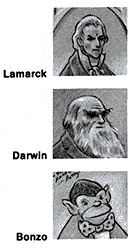
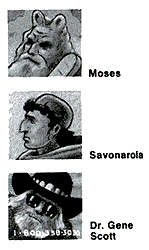
Creationism vs. Evolutionism
There are still differences of opinion about the descent of man. In the past, there have been bitter disputes over what doctrines should be taught, especially in public schools.Today however, we understand that all theories should be given equal weight and taught side-by-side. Accordingly, we will outline the two schools of thought and demonstrate the advantages that result from this evenhanded approach.
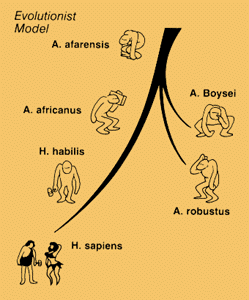 |
EvolutionismEvolutionists hold that man arose by the same gradual process as other creatures. This belief follows from the principle that the same laws of nature apply to man as to the rest of the physical world.The Evolutionist Model (at left) demonstrates how an ancestral "ape-man" could have evolved an upright stance and humanlike physiology. However, it does not explain the tremendous expansion of the intellect and other intangibles that characterize humanity. |
CreationismCreationists, on the other hand, believe that man was created instantaneously by a cosmic powered super-being from another dimension. This belief is based on ancient, heavily retranslated writings taken from badly decomposed fragments of scroll found in a series of caves in the middle-east.The Creationist Model (at right) explains the advent of human intelligence by ascribing it to divine fiat in the creation of the first humans, Adam and Eve. A major weakness is that it fails to account for the origin of Adam and Eve's daughters-in-law. |
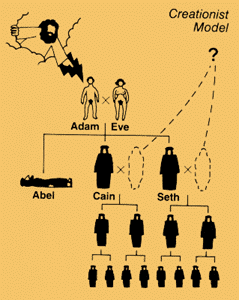 |
A MODERN SOLUTION
Pictured below, we see how an open-minded approach to these conflicting theories can lead to the resolution of a major problem in each.
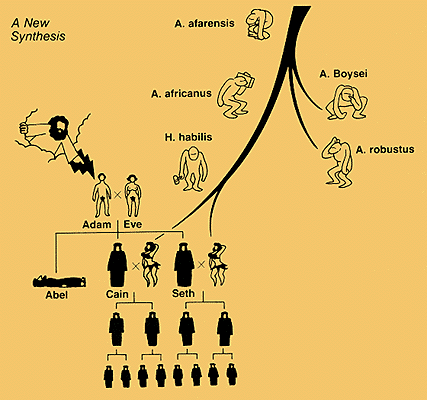
REQUIRED NOTICE: This account meets the statutory and regulatory requirements of all U.S. state, county and municipal school boards and districts for works dealing with the origins of man and is warranted to be suitable for use as a teaching tool in accordance with the Guidlines for De Facto Ideological Uniformity of the American Textbook Publishers Association.
Early Man
 There were many "missing links" between the earliest ancestral apes and modern Homo
Sapiens. Scientists learn about these extinct species from fossil remains.
There were many "missing links" between the earliest ancestral apes and modern Homo
Sapiens. Scientists learn about these extinct species from fossil remains.Here is an example (at left) of a fossil found near the famous "Lucy" fossil discovery. It is the skull of an australopithecine male, named "Desi" by its discoverers. Another couple, named Fred and Ethel, were found in a nearby cave, but Desi is the best preserved specimen.
Scientists can learn much from a relatively small fragment of skeleton. From this fossil, it was deduced that Desi stood about four-foot seven inches tall, walked with a slight limp, disliked zucchini and was a registered Democrat.
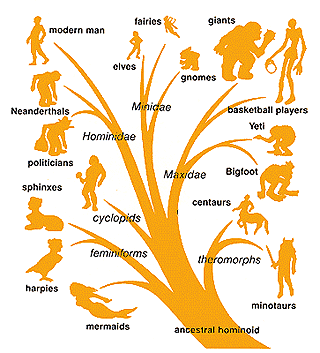 |
Nature's MisteaksMan and the modern apes are not the only families that descended from the ancestral primates. (left) Many early branches of the hominid tree are now extinct, or survive only in isolated areas.
Other fossil remains have yet to be reliably interpreted. (below) |
  |
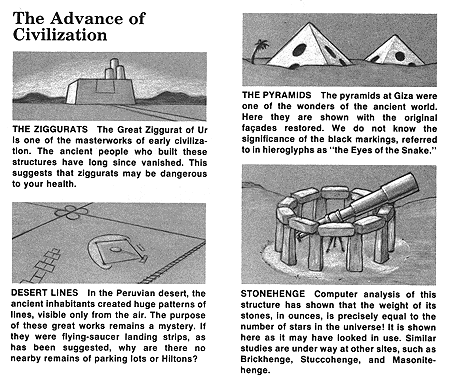

The Noble Savage vs. Civilized ManPrimitive man lived an idyllic existence, in harmony with nature and his fellows. The advance of civilization exacted a price: as the old ways were replaced by the new, tribal man forgot his ancient natural wisdom. | |
|
Among the tribal traditions often displaced by the encroachment of modern
society were:
slavery |
Despite these losses, civilization brought many benefits. Among them were:
slavery |

An artist's conception of life in the 21st century.
Introduction
The Universe /
Matter & Energy /
The Earth /
Evolution /
The Descent of Man